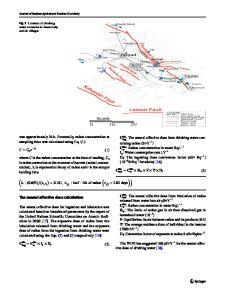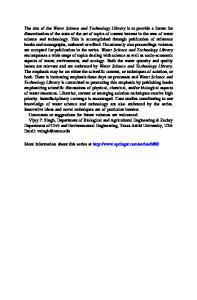Resilient Drinking Water Resources
- PDF / 1,190,654 Bytes
- 15 Pages / 439.37 x 666.142 pts Page_size
- 65 Downloads / 460 Views
Resilient Drinking Water Resources Ritsche A. Kloosterman 1
& Jan Peter van der Hoek
2
& Paulien Herder
2
Received: 30 April 2020 / Accepted: 2 December 2020/ # The Author(s) 2020
Abstract
A significant challenge for managers of drinking water infrastructures is to make effective strategic decisions for assets with a long lifetime in an uncertain and changing environment. Water resources, which are part of the drinking water infrastructures, have a special position in this decision making process as they operate at the interface of the socio-technical and the socio-ecological subsystems: water resources are the input for the technical system, consisting of pipes and pumps that interact with different actors; and water resources can be seen as output from the ecological system which is influenced by environmental and political issues like climate change, drought and competing and changing uses of water and space. This paper discusses how to design the water resources in such a way that they function in the desired way at present, but that the design also fits an uncertain future as good as possible. To this extent, a framework was developed based upon the notion of resilience. Existing general design principles for socio-technical systems from literature were used as building blocks in the development of our water resources design principles (WR-DP) framework. Three key characteristics of water resources were distinguished in this framework: water quantity, water quality and the environmental impact of the water resources. In addition, we distinguished two dimensions that allowed us to explicitly describe all possible design principles: system scale and class. The first dimension, system scale, ranges from one water resource to a network of water resources. The second dimension, class, makes a distinction between social aspects and technical aspects. Application of the WR-DP framework in a case of a drinking water company in the Netherlands showed the usability of the framework. Keywords Drinking water infrastructures . Water resources . Resilience . Strategic decisions . Socio-technical system . Socio-ecological system . Long term planning
1 Introduction The drinking water infrastructure (DWI) is a critical societal infrastructure that provides the essential service of drinking water supply (Doorn et al. 2019). Pipes, water resources and other
* Ritsche A. Kloosterman [email protected] Extended author information available on the last page of the article
Kloosterman R.A. et al.
assets of DWIs can have life times up to 100 years and during that period the desired services of DWIs and the functioning of DWIs can change dramatically due to demographic changes, changes in the way drinking water is used, economic changes, climate change etc. Assets of DWI are capital intensive and it takes a long period to develop new assets, mainly due to investigations about the suitability of the water resources, environmental impact studies and procedures to get the licenses. For example, developing a new ground
Data Loading...











